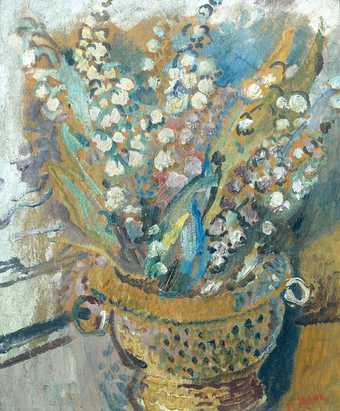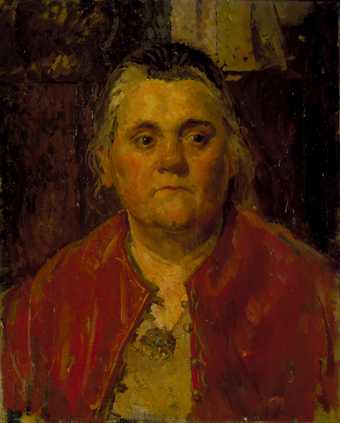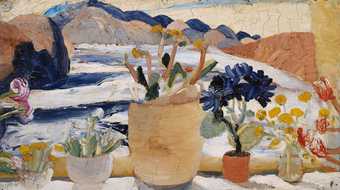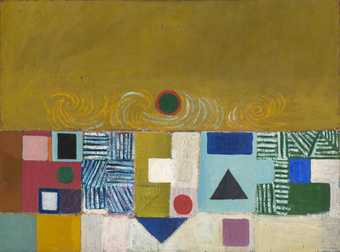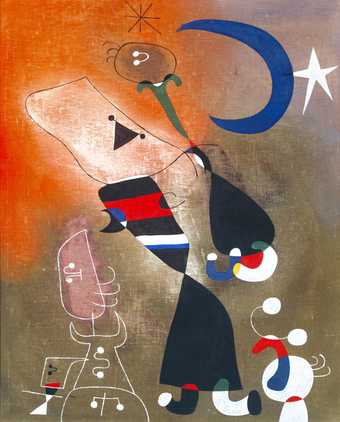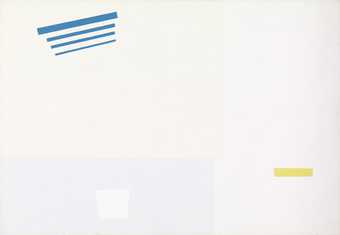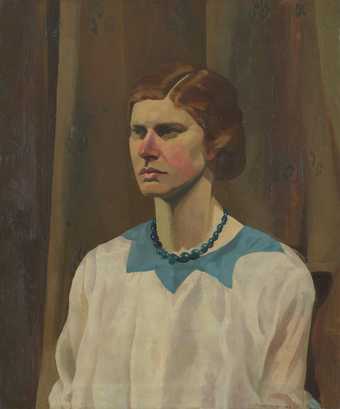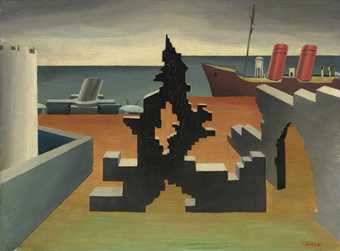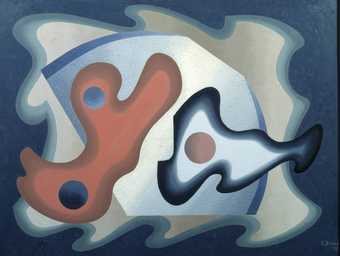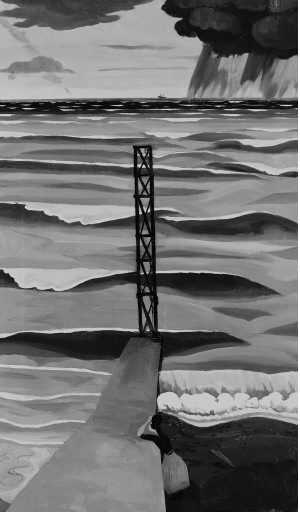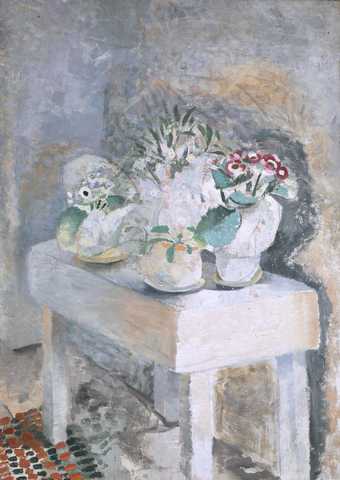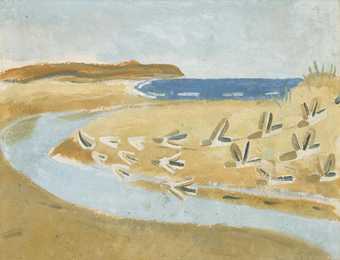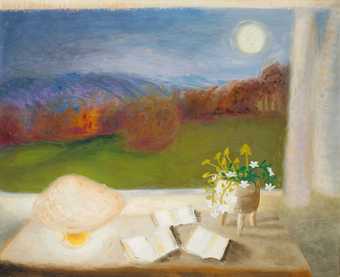
In Tate Modern
- Artist
- Winifred Nicholson 1893–1981
- Medium
- Oil paint on canvas
- Dimensions
- Support: 762 × 889 mm
frame: 831 × 960 × 89 mm - Collection
- Tate
- Acquisition
- Purchased 1975
- Reference
- T01996
Summary
Moonlight and Lamplight 1937 is a rectangular abstract painting by British painter Winifred Nicholson. The work features a large flat off-white circle, a russet-coloured pentagon and a wide central vertical greyish-white band that is bowed slightly on its right side. The white circle is positioned in the left of the composition while the russet pentagon tilts slightly inwards from the right, so that overlaps with the central band. On top of the band are layered four additional flat shapes: three pale grey rectangles and one pale blue geometric form. The background of the work is a vibrant yellow ochre, but on the left-hand side there is a thin overlay of off-white paint that dampens the intensity of the colour in that area.
Nicholson made Moonlight and Lamplight in her apartment at 48 Quai d’Auteuil in Paris’s sixteenth arrondissement in 1937. Nicholson painted on both sides of this canvas, blanking out the reverse composition with blue and white paint before restretching. She applied the oil paint with a mostly dry brush leaving some small areas of exposed ground and also abraded the dry painted surface with sandpaper or wire wool leaving fine scratch marks and causing some paint loss in the central section. Some graphite trace lines of a preparatory sketch are also visible in the finished work. The title of the work and the artist’s name are inscribed on the stretcher.
The artist began spending winters in Paris between 1932 and 1938 after the breakdown of her marriage to the British abstract artist Ben Nicholson in order to ‘get to know about abstract art’ (quoted in The Tate Gallery 1974–6: Illustrated Catalogue of Acquisitions 1978, p.134). Prior to her move to Paris Nicholson was recognised as a figurative, landscape and flower painter – all subjects deemed appropriate for a female painter by art critics in the 1920s and 1930s. While in France Nicholson befriended several prominent abstract artists including Piet Mondrian (who would return to London with her in 1938), Constantin Brancusi, Hans Arp, George Braque, Alberto Giacometti and Naum Gabo. The ideas of these artists were a crucial influence on Nicholson’s work during this period, as were the artistic exchanges she maintained with Ben Nicholson.
The first abstract paintings Nicholson produced date from around 1934 and were mostly angular with clean lines (see Quarante Huit Quai d’Auteuil 1935, Tate T01995). Later works such as Moonlight and Lamplight 1937 began to incorporate softer edges, illustrating a departure from the influence of her Parisian contemporaries and the formulation of her own specific style of abstraction. Art historian Christopher Andreae has observed that Nicholson’s abstract works never feel ‘technically perfect’ in the way that Ben Nicholson, Mondrian or Gabo’s might, but are rather deliberate attempts to reflect what she viewed as the inexact and imperfect qualities of life (Andreae 2009, p.125).
In the same year that Moonlight and Lamplight was painted Nicholson was invited to publish an essay on colour by Gabo in the journal Circle: International Survey of Constructivist Art. Nicholson wrote in her contribution that she was ‘using colour to express colour – the form could take whatever form the colour wanted’ (see Tate, London 1978, p.135). Having embraced abstraction, Nicholson contended that ‘material resemblances were of no account – and that art could be valid without resemblances to physical objects’ (see The Tate Gallery 1974–6: Illustrated Catalogue of Acquisitions 1978, p.135). Returning to the UK in 1938, Nicholson began to re-establish herself as a landscape and figurative painter, arguing that in the aftermath of the Second World War it was no longer possible to supress emotion or summon the necessary clinical detachment needed to produce the kind of mathematical abstract works she had painted in Paris during the early 1930s (see Andreae 2009, p.131).
Further reading
The Tate Gallery 1974–6: Illustrated Catalogue of Acquisitions, London 1978, pp.134–5, reproduced p.134.
Winifred Nicholson, ‘Unknown Colour. Circle: International Survey of Constructivist Art 1937’, in Andrew Nicholson, Unknown Colour: Paintings, Letters, Writings by Winifred Nicholson, London 1987, pp.99–103.
Christopher Andreae, Winifred Nicholson, Farnham 2009, reproduced p.120.
Judith Wilkinson
March 2016
Supported by Christie’s.
Does this text contain inaccurate information or language that you feel we should improve or change? We would like to hear from you.
Display caption
Having embraced abstraction, Nicholson contended that ‘material resemblances were of no account - and that art could be valid without resemblances to physical objects’.
Writing the year Moonlight and Lamplight was painted, Nicholson stated that she was ‘using colour to express colour - the form could take whatever form the colour wanted’. She was ‘never interested in form, or shape or volume or mass to express colour,’ but ‘studied the way the rainbow prisms break up white light into colour and ... the balance and pose of the weight of one colour against another’.
Gallery label, April 2012
Does this text contain inaccurate information or language that you feel we should improve or change? We would like to hear from you.
Catalogue entry
T01996 MOONLIGHT AND LAMPLIGHT 1937
Inscribed on stretcher ‘Moonlight and Lamp Light Winifred Nicholson 1937’
Oil on canvas, 36×35 (76.3×88.9)
Purchased from the artist (Grant-in-Aid) 1975
Exh: Winifred Nicholson: Paintings 1930–74, LYC Museum and Gallery, Banks, Brampton, Cumbria, December 1974–January 1975 (works not numbered); An Unknown Aspect of Winifred Nicholson, Crane Kalman Gallery, October 1975 (1)
The following catalogue entry is based on discussions with and a letter from Winifred Nicholson of October and November 1975 and has been approved by her.
Winifred Nicholson went to live in Paris at about the end of 1932 because, as she says, ‘I wanted to get to know about abstract art’. She met Mondrian, Brancusi, Arp, Madame Arp, Braque, Giacometti, Hélion and Domela. Her first paintings made in Paris were still figurative and the first abstract works, which were hard-edged, date from about 1934. In later works such as ‘Moonlight and Lamplight’ T01996 the shapes had softer edges. Winifred Nicholson painted figurative pictures throughout her stay in Paris and the last abstract work dates from before the time of her return to England in May 1938. Only one abstract painting was exhibited in the thirties, a gouache, based upon the annular rings seen in cross sections of tree trunks, which was shown in 1935 at the 7 and 5 Society exhibition.
None of the abstract works were sold in the 'thirties. Almost all the surviving ones were exhibited at the LYC Gallery, Bank, Brampton, Cumbria in December 1974 and January 1975, and at the Crane Kalman Gallery in October 1975. The latter exhibition included altogether 26 abstract works.
Winifred Nicholson wrote an article on ‘Unknown Colour’ in Circle (published 1937) using the name of Winifred Dacre, an old family name. In her abstract works Winifred Nicholson says that she was ‘using colour to express colour-the form could take whatever form the colour wanted’. She was ‘never interested in form, or shape or volume or mass to express colour’. She ‘studied the way the rainbow prisms break up white light into colour/and/ ... the balance and pose of the weight of one colour against another’. She studied ‘the direction of light and the universal gravitation and pull of radiation’. ‘Any metaphysical considerations of mine came from the philosophy of the thought that matter did not exist-only spiritual purpose-and therefore material resemblances were of no account-and that art could be valid without resemblances to physical objects’.
When T01995 was shown at the 1965 Marlborough Fine Art exhibition Art in Britain 1930–40 the title ‘Circle and Ellipse’ was invented for the occasion, but misprinted in the catalogue as ‘Circle and Eclipse’. The definitive title is ‘Quarante Huite Quai d'Auteuil’, the address of the artist's apartment in Paris where it was executed. She recalls that the street name was later changed to the Quai Louis Blériot.
Winifred Nicholson said that a gouache, similar to T01995, shown at the 1975 Crane Kalman exhibition may have been mistakenly dated 1927 in the catalogue.
The title of T01996 was given to the work after it was completed. She ‘may have had in mind the opposite ideas of moonlight and lamplight while painting the work’.
Published in:
The Tate Gallery 1974-6: Illustrated Catalogue of Acquisitions, London 1978
Explore
- abstraction(8,615)
-
- from recognisable sources(3,634)
-
- man-made(999)
- non-representational(6,161)
- formal qualities(12,454)
-
- light(150)
- contrast(176)
- heating and lighting(846)
-
- light / lamp(264)
You might like
-
Malcolm Milne Lilies of the Valley
1927 -
F. Ernest Jackson Mrs Beasley
c.1937 -
Winifred Nicholson Window-Sill, Lugano
1923 -
Victor Pasmore Square Motif, Blue and Gold: The Eclipse
1950 -
Joan Miró Women and Bird in the Moonlight
1949 -
William Scott Orange, Black and White Composition
1953 -
Alastair Morton Opus 15 (Light Blue and Yellow)
1938 -
Winifred Nicholson Quarante Huit Quai d’Auteuil
1935 -
Richard Carline Portrait of Hilda Carline
1918 -
John Bigge (Sir John Amherst Selby-Bigge, Bt) Dieppe
1931 -
John Bigge (Sir John Amherst Selby-Bigge, Bt) Composition
1933 -
Richard Carline Sea Shore
1920 -
Winifred Nicholson Flower Table
1928–9 -
Winifred Nicholson Sandpipers, Alnmouth
1933 -
Winifred Nicholson The Hunter’s Moon
1955

